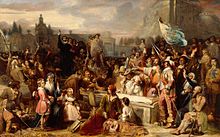Greyfriars Kirkyard is the graveyard surrounding Greyfriars Kirk in Edinburgh, Scotland. It is located at the southern edge of the Old Town, adjacent to George Heriot's School. Burials have been taking place since the late 16th century, and a number of notable Edinburgh residents are interred at Greyfriars. The Kirkyard is operated by City of Edinburgh Council in liaison with a charitable trust, which is linked to but separate from the church. The Kirkyard and its monuments are protected as a category A listed building.
Greyfriars takes its name from the Franciscan friary on the site (the friars of which wear grey habits), which was dissolved in 1560. The churchyard was founded in August 1562 after Royal sanction was granted to replace the churchyard at St Giles' Cathedral in Edinburgh. The latter burial ground was not used after around 1600.
Because it is thoct gude that thair be na buriall within the Kirk, and that the kirk-zaird is nocht of sufficient rowme for bureing of the deid, and for esdrewing of the savour and inconvenientis that may follow thairupon in the heit of somer, it would be providit that ane buriall place be maid farrer from the myddis of the town, sic as in the Greyfreir zaird and the somyn biggit and maid close.[1]
Because it is thought beneficial that there should be no more burials within the church [ie St Giles], and because that kirkyard is not thought to have sufficient room for burying the dead, and taking into consideration the smell and inconvenience in the heat of summer, it would be provided [by the council] that a burial place be made further from the middle of town, such as in Greyfriars yard, and the same [should be] built up and made secure.
 An oil painting of The Signing of the National Covenant in Greyfriars Kirkyard by William Allan (painter) in 1838
An oil painting of The Signing of the National Covenant in Greyfriars Kirkyard by William Allan (painter) in 1838 Greyfriars Kirkyard with Edinburgh Castle behind
Greyfriars Kirkyard with Edinburgh Castle behind "Non Omnis Moriar" ("Not All of Me Will Die"), Greyfriars Kirkyard, Edinburgh
"Non Omnis Moriar" ("Not All of Me Will Die"), Greyfriars Kirkyard, Edinburgh Hill & Adamson photograph dated 1848, showing D O Hill sketching at the Dennystoun Monument, watched by the Misses Morris
Hill & Adamson photograph dated 1848, showing D O Hill sketching at the Dennystoun Monument, watched by the Misses MorrisThe Kirkyard was involved in the history of the Covenanters. The Covenanting movement began with signing of the National Covenant in Greyfriars Kirk on 28 February 1638. Following the defeat of the militant Covenanters at Bothwell Brig in 1679, some 1200 Covenanters were imprisoned in a field to the south of the churchyard. When, in the 18th century, part of this field was amalgamated into the churchyard as vaulted tombs the area became known as the "Covenanters' Prison".
During the early days of photography in the 1840s the kirkyard was used by David Octavius Hill and Robert Adamson as a setting for several portraits and tableaux such as The Artist and The Gravedigger.
Covenanters Martyrs' Monument (left), commemorating James Guthrie, James Renwick, the Marquis of Argyll and the other Covenanters who died during 'The Killing Time' (1661–88)
Martyrs' Monument (left), commemorating James Guthrie, James Renwick, the Marquis of Argyll and the other Covenanters who died during 'The Killing Time' (1661–88)The National Covenant was signed in the graveyard (as it was a place of legal free public assembly) in 1638. Whilst some depictions of the event show them leaning on table-stones, these stones did not exist at that time and the signing was done during the period of ban on central gravestones.[2]
Following the Battle of Bothwell Bridge (22 June 1679), some 1200 prisoners were brought to Edinburgh. Their being too numerous for containment in the prison or castle a makeshift "prison" was formed in a field south of Greyfriars Kirkyard, to hold around 400 not containable elsewhere. This area was conveniently enclosed on two sides by the Flodden Wall and on a third side (the west) by the high enclosing wall of George Heriot's School. The fourth side faced the churchyard and was separated by an easily patrolled and guarded picket fence.[3]
The name Covenanters Prison stuck. The bulk of the area was built on by the city Bedlam (around 1690). A remaining strip of land, sandwiched between the Bedlam and George Heriot's School, was used for additional burial ground from around 1700. The style at the time was to build in enclosed vaults, and this is the dominant form in this section. As the vaults did not exist at the time of the area's prison use, despite their potential to be used as prison cells, this was never the case.
The area was open to public view until around 1990, but was thereafter locked by City of Edinburgh Council to stem persistent vandalism and use by drug-users. The area is accessible during the day by special arrangement with the guides at Greyfriard Kirk[4] during their opening hours and at night by going on a City of the Dead Tour where the Black Mausoleum can be visited.[5]
Greyfriars BobbyThe graveyard is associated with Greyfriars Bobby, the loyal dog who guarded his master's grave. Bobby's headstone at the entrance to the Kirkyard, erected by the Dog Aid Society in 1981, marks his reputed burial place, however as there are no parts of the kirkyard that is not consecrated it is also believed he was buried under a tree outside the gates to the right of the current main entrance. The dog's statue is opposite the graveyard's gate, at the junction of George IV Bridge and Candlemaker Row. The grave of a Pentland Hills Shepherd, "Auld Jock" (John Gray), where the dog famously slept for 14 years, lies on the eastern path, some 30m north of the entrance. The stone is modern, the grave originally being unmarked.





































Add new comment